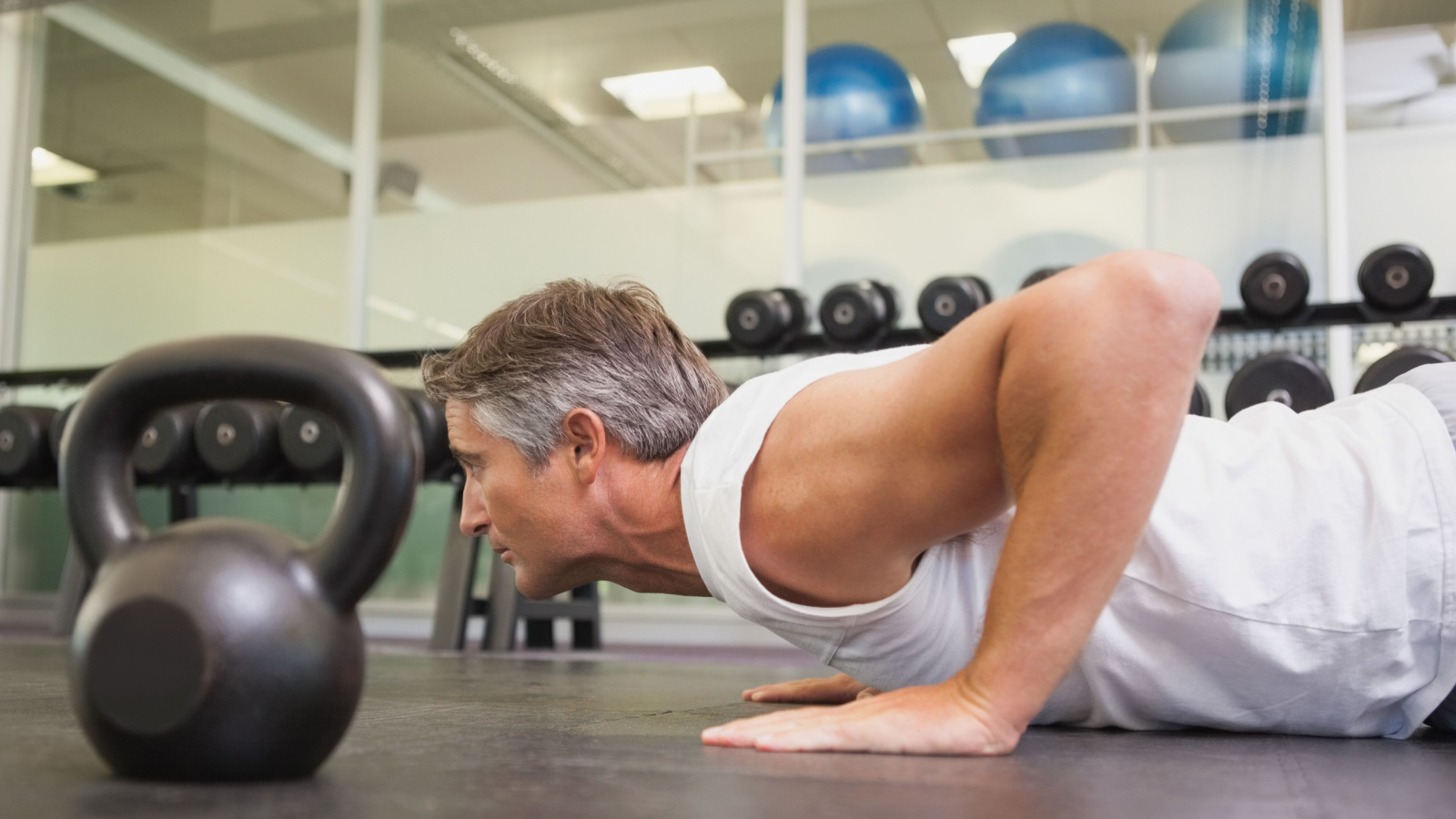
The gym is for everyone. It’s for bodybuilders working to reach 5% body fat on stage and powerlifters who want to bench press 500 pounds. The gym is also for folks who have some gray in their hair, some well-earned laugh lines, and a few general aches and pains from more than two decades of “adulting” — that’s a term today’s kids use for the thing we just call “life.”
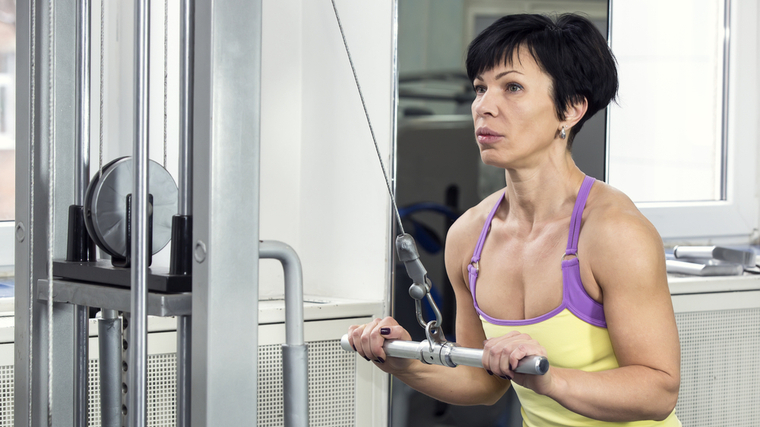
If you’re checking the 40 or above age bracket on doctors’ forms, right before that doctor says, “You really should get more exercise,” you need to approach the gym with a few rules in mind. Not to be a buzzkill, but you can’t train like a 20-something because you don’t recover like a 20-something.
That certainly doesn’t mean Gen-Xers in the gym (Gym Xers?) are as delicate as the splinter-laden seesaws that used to be on the playground. You’re not stuck with light weight machine-based training or water aerobics, but you need to follow a few guidelines to get results with less pain. Here’s what to know about getting fit when you’ve got decent mileage on the chassis.
Over 40 Training Guide
Why Age Matters
The years eventually pile up on everyone and force change. Whether it’s Jennifer Grey going from an “it girl” to “who’s that girl?” or Green Day moving from punk rock revolution to Broadway musical, what matters most is acknowledging and accepting that everyone does, eventually, grow up. Just as sure as you can count on your favorite ’80s flick being resurrected as a weak remake, you can count on your body adapting to the added years. And, in both cases, it happens whether or not you want it to.
As you get older, wear and tear will eventually affect you whether it comes from lifting weights, playing tennis, working manual labor, or basic day-to-day activities. If you want to continue performing any of those activities for the long haul, it’s critical that you approach them with some kind of plan in mind.
However, this isn’t a proverbial (let alone literal) death sentence. It simply means that, if you want to begin weight training and other forms of exercise, you need to take a well-thought-out approach that will let your current body carry out the necessary pursuits.

Particularly when it comes to weight training, research suggests that muscular recovery takes longer as a person ages. (1) So your weekly weight training plan needs to accommodate a slightly longer recovery period between sessions.
A relatively older body also doesn’t respond to volume or intensity the same way a younger body responds, so you need to establish a more carefully calculated approach to sets, repetitions, and load (weight). (2)
Lastly, if you’re coming in to the gym with any pre-existing injuries or conditions — which, of course, were totally caught early because you’ve gotten the classic full medical check-up before starting a training routine — those issues will directly impact the exercises you can or cannot (and should or should not) do. You might have your heart set on benching 315, but if you’ve lived with a torn rotator cuff since college, the lift probably isn’t in the cards.
Training for the Over 40 Beginner
There are plenty of successful competitive bodybuilders, powerlifters, Olympic weightlifters, and CrossFit athletes in their 40s, 50s, and beyond. That should indicate a clear sign that you can and should participate in some type of weight training at any age. But unless your actual goal is to compete in a specific strength sport, you’ll be best served by taking a wider outlook on how you plan your training program.
Remember in the early ‘90s when a new sport called “mixed martial arts” appeared on the scene? It highlighted what happened when a kickboxer fought a wrestler or a karate practitioner tussled with a taekwondo expert.
What eventually became obvious (over sequential MMA events and, inevitably, over the years) was that hyper-focusing on one single avenue of training limited overall development. The best modern-day mixed martial artists aren’t just a master of a single fighting style — they’re excellent at a few forms of combat.
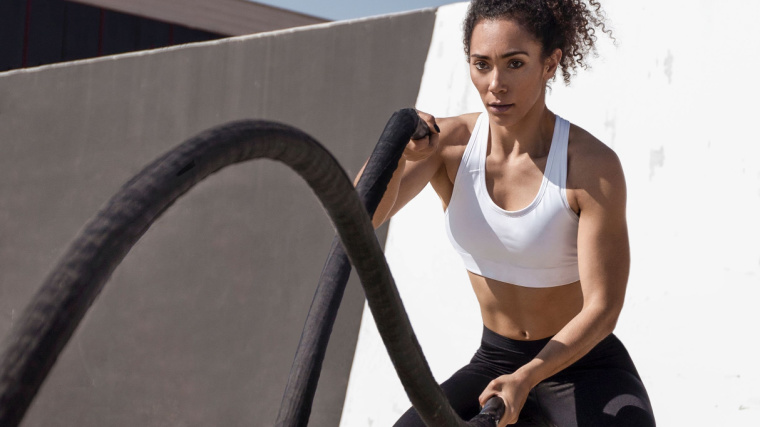
To safely and effectively start training as a mature lifter, you must adopt that same well-rounded mindset. Train like a mixed martial artist. More specifically, don’t come into the training world expecting to train “like a powerlifter,” or “like a bodybuilder,” or any other relatively narrowed lens unless you have intentions of competing in a particular strength sport. But the odds are you don’t; you’re probably just here to get in shape. Here’s how you’ll get it done.
Choose The Right Exercises
Generally speaking, when it comes to picking your exercises, forget anything you’ve heard about “must-do” movements. The powerlifting big three — back squat, bench press, and conventional deadlift — are often touted as “the way” to build a base of size and strength. That’s well-intentioned advice but inapplicable and unnecessary for the over-40 crowd.
While there’s nothing inherently wrong with those three specific exercises, they’re not overwhelmingly more effective than, say, front squats, overhead presses, and trap bar deadlifts. Again: If you’re not going to be a competitive powerlifter, you’re not limited to training like a competitive powerlifter.
Choosing a variety of multi-joint and single-joint exercises will efficiently target your entire body without neglecting or over-emphasizing anything. Be sure to incorporate a range of equipment like barbells, dumbbells, cable pulleys, machines, resistance bands, kettlebells, and any useful gear you find in the gym. This can help reduce potential overuse pattern injuries compared to performing the same five exercises for months.
Most importantly, don’t force-feed your body any exercise that doesn’t mesh with your pre-existing joint issues. Suppose you have long legs for your height. In that case, you may be more comfortable performing sumo deadlifts instead of using a closer, conventional stance, even though Internet meme culture will try to convince you that sumo deads are a lesser choice.
Sets and Reps
A popular old school mindset used to advocate throwing everything plus the kitchen sink into a training session. The goal was to thoroughly breakdown the muscle fibers and dig a deep trench of fatigue that “should” later be filled in with an abundance of new muscle tissue. However, a moderate workload can stimulate muscle and strength gains more efficiently than a super-high volume plan that blasts every body part with multiple exercises for a half-dozen sets of each movement.
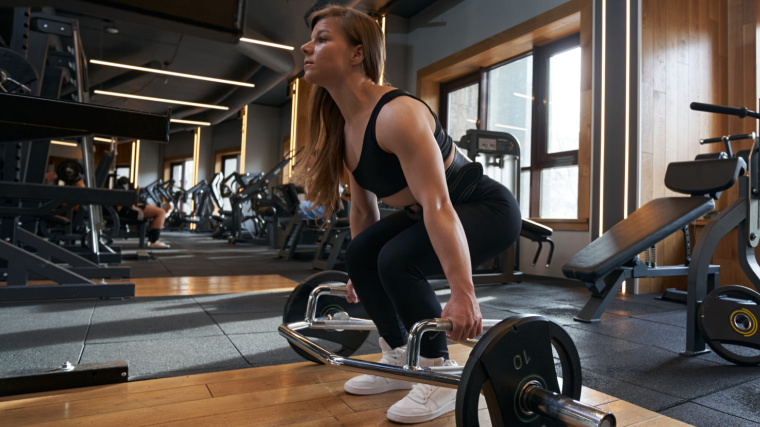
The specific exercises will play a factor in determining adequate volume for each movement. For example, you typically wouldn’t perform a deadlift for sets of 20 reps because cardiovascular conditioning and low back fatigue would become the limiting factor before other target muscles.
Generally speaking, six to 10 sets of five to 12 reps per body part per week is an effective place to start. (3) Ideally, this would be split into multiple movements across multiple weekly training sessions. Relatively larger body parts like your back and legs could necessitate the higher end of the workload. Smaller body parts like biceps or abdominals can be sufficiently trained with a lesser amount of direct training.
For example, you might perform five sets of lat pulldowns and three sets of cable curls on Monday, followed by five sets of rows and three sets of dumbbell curls on Thursday. Or you could train “back and biceps” one day per week and tackle three to four sets of deadlifts, rows, chin-ups, followed by two or three sets of preacher curls and hammer curls.
As a very general rule, strength-focused lifts that let you load relatively heavier weights are effective when trained with three to five sets of four to six reps. Exercises that aren’t conducive to heavy loading, like many single-joint movements, can be more effectively trained with two to four sets of eight to 12 reps.
How Heavy, How Hard?
Due to a relatively reduced capacity to recover, don’t turn the dial up to 11 in any particular training session. You want to make it through your workout and walk out of the gym feeling successful, not beaten down.
Avoid taking too many (if any) sets to complete muscular failure. Pushing to failure too often can potentially compromise technique, which can invite injury. It also increases overall recovery demands while providing little to no extra stimulus for building size or strength. (4)
Similarly, the weight used for any set should allow you to reach your target rep range with solid form. Struggling to complete a set whenever needed is fine; compromising your form and cheating the movement to get an extra rep or two is a high-risk/low-reward idea.
How Many Days Per Week?
Many people spend 40 to 50 hours per week working. Add in a daily commute, time with family, and maybe even a little time to eat every day, and your schedule can quickly become too crowded for the gym. Making time to train is one of the biggest hurdles you’ll need to overcome before you even touch a weight.
Rather than overwhelm your week by trying to fit five or more workouts into an already crowded schedule, consider starting with three weight training sessions per week. When properly programmed, and paired with a little non-gym activity, that can be a highly effective approach.
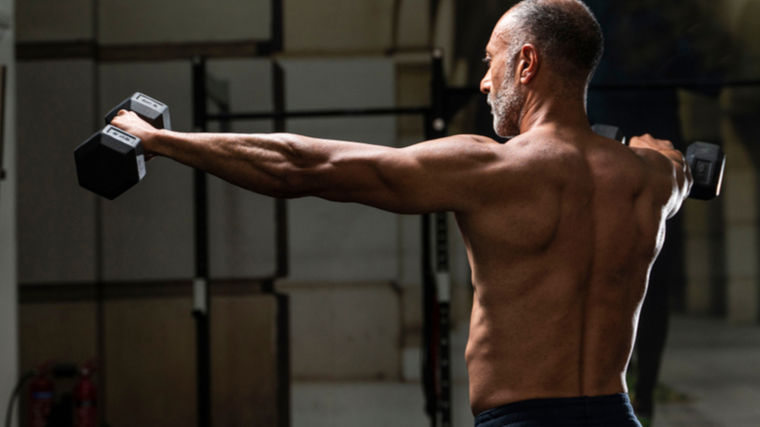
Rather than training just one or two body parts per day, which would require at least five training days to target your entire body, consider following an upper/lower split, a push/pull/legs plan, or a full-body training routine to set up more efficient training within the framework of three sessions per week.
On any non-lifting days, you can perform short conditioning workouts or some type of cardio training to complement the gym sessions. By staying active throughout the week, you’ll burn a few extra calories and improve your cardiovascular health. In fact, when performed as part of a comprehensive program, doing some type of cardio exercise for as little as three hours (total) per week has been associated with a reduced mortality risk. (5)
Combine that with research indicating that weight training for 60 minutes per week (a bare minimum target) is also associated with reduced mortality risk, and it’s clear why the doctor keeps harping on you to start exercising. (6) If you’re active more days of the week than not, you’ll be moving in the right direction in terms of health, physique, and performance.
Nutrition and Recovery Tips
If going to the gym was all it took to get into great shape, well, it would be a lot easier for everyone to get into great shape. However, training is only one part of the puzzle. Just like Ferris had Sloane and Cameron, your training needs support from good nutrition habits and recovery methods.
Nutrition
Once you’ve made the decision to begin training, you’ve also made the decision to support that training with a goal-focused nutrition plan. They’re linked. Otherwise, you’ll end up wasting time and energy because you won’t be able to capitalize on the fat-burning, muscle-building training stimulus.
Whether your goal is to drop some body fat or pack on more lean muscle, it’s important to pay attention to your protein intake (the critical building block for muscle tissue), monitor your total calories, and adjust on a weekly or biweekly basis according to results.

There are countless specific nutrition plans available, with varying degrees of effectiveness. If you can adhere to a handful of tips, you’ll be able to stay on course.
- Drink as few calories as possible — This includes fruit juice, soda, high-sugar coffee drinks, and alcohol.”Liquid calories” often add up quickly and sneakily, which can be a deal-breaker if you’re trying to shed some pounds.
- Drink more water — Inconceivable, right? Drink water to improve your health. It’s still worth repeating. Proper hydration can improve everything from your blood pressure to your in-gym performance. (7) Get a half-gallon jug and finish it every day.
- Have high-quality protein every time you eat — Carbohydrates and fats can be very important nutrients to fuel performance in and out of the gym. However, ample protein from quality sources is the only way to build more muscle tissue. Aim for .75 to one gram of protein per pound of body weight. (8)
- Eat fresh, home-cooked food more than you eat out — Consider this the “pack a lunch, don’t hit the drive-thru” rule. Highly processed foods have been associated with higher saturated fat, higher sugar, and increased body fat gain compared to less processed foods. (9)(10)
Recovery
Train all you want, but without ample recovery, you won’t get any closer to your goals. As a slightly older lifter, you’ll benefit from focusing on general recovery methods to support your training efforts. (1)
One of the most efficient ways to improve your daily recovery is to improve your sleep quality and, as best as possible, sleep quantity. Poor sleep habits have been shown to negatively impact hormone levels, strength levels, and lean muscle mass. (11)
Another overlooked recovery booster is going for a walk. Daily or frequent walks have been shown to improve cardiovascular health and fat loss. (12) Walk the dog, walk your kids to the bus stop, walk the grandkids to the playground, whatever gets the job done.
If you start your training plan and feel like it’s still too much to handle, consider swapping one workout day for a day of exercise “snacks.” These brief mini-sessions, lasting less than five minutes each, can be used either as a cardio alternative or for strength training. When done consistently, this can boost cardiovascular fitness. (13)
When you apply this throughout-the-day method to strength training exercises, it’s known as “greasing the groove” and it can be an excellent way to improve exercise technique, build strength, and trigger muscle growth. It’s most commonly applied to bodyweight exercises like push-ups or pull-ups, but it can be performed with weighted movements as well.
Mobility
If you’ve started calling your ankles, knees, and wrists “Snap, Crackle, and Pop” because of the constant noises they make, it’s probably time for some mobility work. Whether it’s a few minutes of simple stretching, an online yoga class, or some time spent on a foam roller, you can significantly reduce the general aches and pains by treating mobility work with a bit of attention.
Mobility training could technically be considered an adjunct to recovery, since it can enhance general blood flow, improve flexibility, and reduce post-workout soreness. Whichever way you want to categorize it, make sure it’s on your weekly to-do list.
Don’t want to spend an entire session on mobility drills? Then try starting every weight training workout with two or three reps of the Turkish get-up. That’s one “hack” to finding out exactly where your body needs work since it’s a total-body movement that involves your ankles, knees, hips, core, elbows, shoulders, and upper back in a single go.
Sample Workout Plan
You need some strength work, and some muscle-building work, and some conditioning, and some mobility training. Fortunately, you don’t have to do everything in every workout. Plan on hitting the gym three days per week, alternating between two basic full-body workouts. Save one or two additional days for cardio/conditioning sessions and plug them in according to your schedule.
The only rule with this workout design is to not perform the same type of workout two days in a row. For example, a weight training workout can be followed by a rest day or a cardio/conditioning day, not another weight training workout.
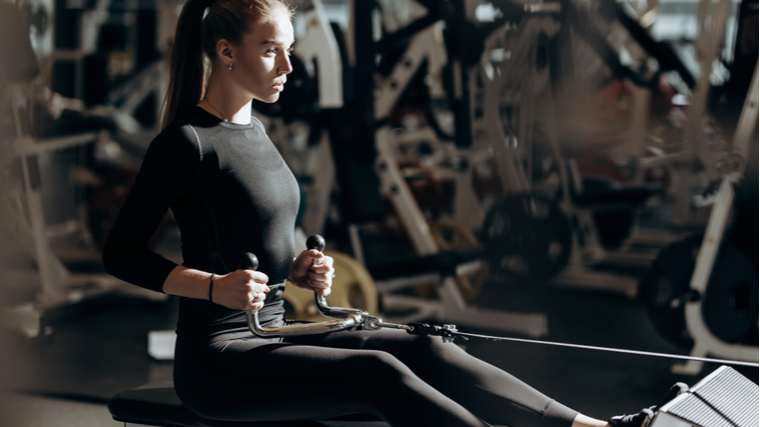
The details of the program (exercises, sets, and reps) can be adjusted according to your specific goal, but this is an effective “all-around” starter program to become acclimated to consistent training.
Weight Training Workout One
Rest two minutes between sets of the first exercise. Rest 45 to 60 seconds between sets for other exercises.
Weight Training Workout Two
Rest two minutes between sets of the first exercise. Rest 45 to 60 seconds between sets for other exercises.
Cardio/Conditioning Workout One
Perform the following as a complex — perform one set of each exercise with no rest between movements. Rest 90 seconds after the final exercise before repeating the entire sequence. Use the same barbell and the same weight for each exercise.
Cardio/Conditioning Workout Two
Complete the farmer’s walk. Follow with a regular, plain ol’, unweighted walk either immediately or later in the day.
Welcome to the First Day of the Rest of Your Life
The Kurgan was wrong. It’s definitely not better to burn out than to fade away. Fortunately, with the right approach, you don’t have to do either. Whatever prompted you to start hitting the gym — whether it was a health scare, a little grandbaby you want to see get married some day, or just a desire to look great at your 30th high school reunion — follow the plan and you just might feel like you’ve gone back in time.
References
- Fell, J., & Williams, D. (2008). The effect of aging on skeletal-muscle recovery from exercise: possible implications for aging athletes. Journal of aging and physical activity, 16(1), 97–115. https://doi.org/10.1123/japa.16.1.97
- Foster, Carl & Wright, Glenn & Battista, Rebecca & Porcari, John. (2007). Training in the aging athlete. Current sports medicine reports. 6. 200-6. 10.1007/s11932-007-0029-4.
- Borde, R., Hortobágyi, T., & Granacher, U. (2015). Dose-Response Relationships of Resistance Training in Healthy Old Adults: A Systematic Review and Meta-Analysis. Sports medicine (Auckland, N.Z.), 45(12), 1693–1720. https://doi.org/10.1007/s40279-015-0385-9
- Grgic, J., Schoenfeld, B. J., Orazem, J., & Sabol, F. (2022). Effects of resistance training performed to repetition failure or non-failure on muscular strength and hypertrophy: A systematic review and meta-analysis. Journal of sport and health science, 11(2), 202–211. https://doi.org/10.1016/j.jshs.2021.01.007
- Coleman, Carver & McDonough, Daniel & Pope, Zachary & Pope, C.. (2022). Dose-response association of aerobic and muscle-strengthening physical activity with mortality: a national cohort study of 416,420 US adults. British Journal of Sports Medicine. bjsports-2022. 10.1136/bjsports-2022-105519.
- Momma H, Kawakami R, Honda T, et alMuscle-strengthening activities are associated with lower risk and mortality in major non-communicable diseases: a systematic review and meta-analysis of cohort studiesBritish Journal of Sports Medicine 2022;56:755-763.
- Popkin, B. M., D’Anci, K. E., & Rosenberg, I. H. (2010). Water, hydration, and health. Nutrition reviews, 68(8), 439–458. https://doi.org/10.1111/j.1753-4887.2010.00304.x
- Morton, R. W., Murphy, K. T., McKellar, S. R., Schoenfeld, B. J., Henselmans, M., Helms, E., Aragon, A. A., Devries, M. C., Banfield, L., Krieger, J. W., & Phillips, S. M. (2018). A systematic review, meta-analysis and meta-regression of the effect of protein supplementation on resistance training-induced gains in muscle mass and strength in healthy adults. British journal of sports medicine, 52(6), 376–384. https://doi.org/10.1136/bjsports-2017-097608
- Poti, J.M., Braga, B. & Qin, B. Ultra-processed Food Intake and Obesity: What Really Matters for Health—Processing or Nutrient Content?. Curr Obes Rep 6, 420–431 (2017). https://doi.org/10.1007/s13679-017-0285-4
- Hall, K. D., Ayuketah, A., Brychta, R., Cai, H., Cassimatis, T., Chen, K. Y., Chung, S. T., Costa, E., Courville, A., Darcey, V., Fletcher, L. A., Forde, C. G., Gharib, A. M., Guo, J., Howard, R., Joseph, P. V., McGehee, S., Ouwerkerk, R., Raisinger, K., … Zhou, M. (2019). Ultra-processed diets cause excess calorie intake and weight gain: An inpatient randomized controlled trial of AD Libitum Food Intake. Cell Metabolism, 30(1). https://doi.org/10.1016/j.cmet.2019.05.008
- Auyeung, T. W., Kwok, T., Leung, J., Lee, J. S., Ohlsson, C., Vandenput, L., Wing, Y. K., & Woo, J. (2015). Sleep Duration and Disturbances Were Associated With Testosterone Level, Muscle Mass, and Muscle Strength–A Cross-Sectional Study in 1274 Older Men. Journal of the American Medical Directors Association, 16(7), 630.e1–630.e6306. https://doi.org/10.1016/j.jamda.2015.04.006
- Serwe, K. M., Swartz, A. M., Hart, T. L., & Strath, S. J. (2011). Effectiveness of long and short bout walking on increasing physical activity in women. Journal of women’s health (2002), 20(2), 247–253. https://doi.org/10.1089/jwh.2010.2019
- Jenkins, E. M., Nairn, L. N., Skelly, L. E., Little, J. P., & Gibala, M. J. (2019). Do stair climbing exercise “snacks” improve cardiorespiratory fitness?. Applied physiology, nutrition, and metabolism = Physiologie appliquee, nutrition et metabolisme, 44(6), 681–684. https://doi.org/10.1139/apnm-2018-0675
Featured Image: wavebreakmedia / Shutterstock






